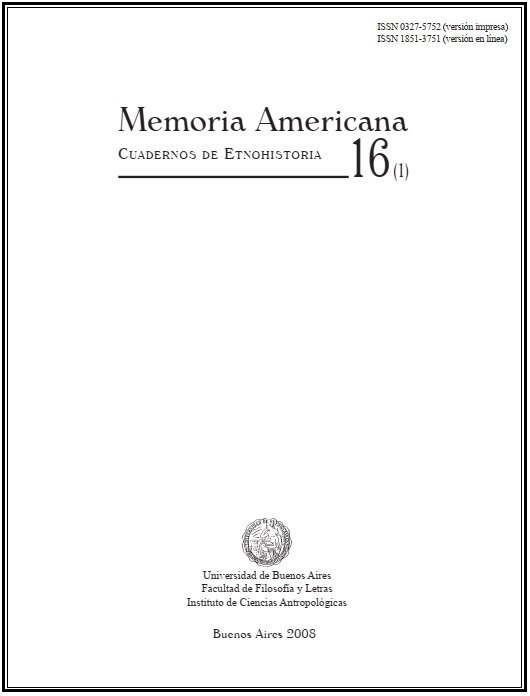Ethnogenesis of an indigenous group located in central Brazil
Abstract
This text analyses the process of ethnic emergence of an indigenous group called tapuios that inhabits the Indigenous Area Carretão, located between the districts of Nova América and Rubiataba, in the state of Goiás, Brazil. This group is the outcome of a settlement policy promoted in Brazil since the beginning of the colonization in the 16th century, until early 19th century. Approximately 20 indigenous settlements were built in the state of Goiás between the years 1741 and 1872. The tapuios are descendents of four indigenous groups who were moved to the Carretão indian settlement, constructed by the royal Portuguese authorities in 1788 and deactivated at the end of the nineteenth century. Hidden in the Brazilian national scene, since the settlement was extinct, the tapuios, since the 1980s, have regained visibility by the birth of a new native group of individuals, sustained by their fight to regain their territory and to recuperate their ethnic identity, two pillars that consolidate the group.Downloads
References
Alencastre, José M. Pereira de 1979. Anais da Província de Goiás - 1863. Brasília, Ed. Gráfica Ipiranga.
Arruti, José Maurício Andion 1995. Morte e vida do Nordeste indígena: a emergência étnica como fenômeno histórico regional. Revista de Estudos Históricos 15: 54-94.
Arruti, José Maurício Andion 2006. A produção da alteridade, o Toré e as conversões missionárias e indígenas. En Montero, P. (org.); Deus na Aldeia: missionários, índios e mediação cultura. Rio de Janeiro, Ed. Globo.
Barreto Filho, Henyo Trindade 1993. Tapebas, Tapebanos e Pernas-de-Pau: etnogênese como processo social e luta simbólica. Disertación de Maestría, PPGAS/Museu Nacional/UFRJ.
Bartolomé, Miguel Alberto 2006. As etnogêneses: velhos atores e novos papéis no cenário cultural e político. Mana. Estudos de Antropologia Social 12: 39-67.
Bonfil Batalla, Guillermo 1981. El pensamiento político de los Indios en América Latina. Anuário Antropológico 79: 11-79.
Cunha, Manuela Carneiro da 1992. Legislação Indigenista no século XIX: uma compilação (1808-1889). São Paulo, Edusp/Comissão Pró-Índio de São Paulo.
Erny, Pierre 1991. Ethnologie de l’éducation. Paris, L’Harmattan.
Hill, Jonathan (org.) 1996. History, Power, and Identity. Ethnogenesis in the Americas, 1492-1992. University of Iowa Press.
Lazarin, Rita Heloisa Almeida 1980. Relatório sobre os índios do Carretão. Brasília, Funai.
Lima, Deborah e Souza, Paulo R. 2006. Nova Dinâmica de Afirmação de Identidades Étnica. En Ricardo,
B. y F. Ricardo (orgs.); Povos Indígenas no Brasil: 2001-2005: 415-417. São Paulo, Instituto Socioambiental.
Lorandi, Ana María 1996. Commentaire. En Gruzinski, S. y N. Wachtel (comp.); Le Nou¬veau Monde, Mondes Nouveaux: l’expérience américaine: 84-89. Paris, Éditions Recherche sur les Civilisations/Éditions de l’École des Hautes Études en Sciences Sociales.
Novaes, Sylvia Caiuby 1993. Jogos de Espelhos: imagens da representação de si através dos outros. São Paulo, EDUSP.
Oliveira, João Pacheco de (org.) 1999a. A viagem de volta: etnicidade, política e reelaboração cultural no Nordeste indígena. Rio de Janeiro, Contra Capa Livraria.
Oliveira, João Pacheco de 1999b. A Problemática dos “Índios Misturados” e os Limites dos Estudos Americanistas: um Encontro entre Antropologia e História. Em 15 Ensaios em Antropologia Histórica: 99-123. Rio de Janeiro, Editora da UFRJ.
Oliveira, Roberto Cardoso de 1976. Identidade, etnia e estrutura social. São Paulo, Livraria Pioneira Editora.
Ossami de Moura, Marlene Castro 2000. Les Tapuios du Carretão: ethnogenese d’un groupe amérindien de l’Etat de Goiás (Brésil). Tesis de Doctorado. Strasbourg, Université Marc Bloch de Strasbourg.
Pohl, Johann Emanuel 1976. Viagem ao interior do Brasil. Belo Horizonte, Ed. Itatiaia/Edusp.
Ribeiro, Darcy 1970. Os índios e a civilização. Rio de Janeiro, Civilização Brasileira.
Ramos, Alcida Rita 1990. Vozes Indígenas: o contato vivido e contado. Anuário Antropológico 87: 117-143.
Copyright (c) 2008 Memoria Americana. Cuadernos de Etnohistoria

This work is licensed under a Creative Commons Attribution-NonCommercial-ShareAlike 4.0 International License.
Los derechos de autor son cedidos a Memoria Americana. Cuadernos de Etnohistoria, no obstante los autores podrán recuperarlos y reproducir su trabajo en otros medios o formatos previo envío de solicitud al Comité Editorial. En tales casos, deberá citarse a Memoria Americana. Cuadernos de Etnohistoria como primera publicación del trabajo y el mismo queda bajo una licencia Creative Commons CC BY NC SA 3.0 Attribution- Non Commercial -ShareAlike 3.0, la cual provee libre acceso inmediato a sus contenidos pues se rige por el principio según el cual hacer disponible -en forma gratuita- la investigación al público fomenta un mayor intercambio de conocimiento a nivel global.
Los autores deberán remitir el siguiente formulario de cesión de derechos y compromiso de originalidad:
Cesión de derechos y compromiso de originalidad
Al Comité Editorial de Memoria Americana, Cuadernos de Etnohistoria
Por la presente declaro ser el autor del trabajo titulado (nombre del artículo), el mismo es original y propio y no ha sido publicado en ningún formato o soporte con anterioridad.
En caso de ser aceptado para su publicación en Memoria Americana. Cuadernos de Etnohistoria (número/año) cedo los derechos editoriales que me corresponden por el aludido artículo para su publicación en todos los formatos que posea la mencionada revista.
Si quisiera publicar este artículo a través de otro editor o en otro lugar me comprometo a solicitar el correspondiente permiso por escrito al Comité Editorial de Memoria Americana. Cuadernos de Etnohistoria. De ser afirmativa la respuesta del Comité Editorial me comprometo a lo siguiente:
- especificar lugar, editorial y fecha de la primera publicación del artículo en la nueva publicación
- realizar esta republicación sólo luego de transcurridos un año calendario desde la fecha de la presente nota de cesión de derechos
FIRMA
Aclaración











